+ Open data
Open data
- Basic information
Basic information
| Entry | Database: PDB / ID: 6u8a | |||||||||||||||
|---|---|---|---|---|---|---|---|---|---|---|---|---|---|---|---|---|
| Title | CBD-bound full-length rat TRPV2 in nanodiscs, state 1 | |||||||||||||||
 Components Components | Transient receptor potential cation channel subfamily V member 2 | |||||||||||||||
 Keywords Keywords | TRANSPORT PROTEIN / ion channel / TRPV2 / TRP channel / cannabidiol | |||||||||||||||
| Function / homology |  Function and homology information Function and homology informationgrowth cone membrane / TRP channels / response to temperature stimulus / positive regulation of calcium ion import / endomembrane system / positive regulation of axon extension / axonal growth cone / monoatomic cation channel activity / calcium channel activity / melanosome ...growth cone membrane / TRP channels / response to temperature stimulus / positive regulation of calcium ion import / endomembrane system / positive regulation of axon extension / axonal growth cone / monoatomic cation channel activity / calcium channel activity / melanosome / lamellipodium / positive regulation of cold-induced thermogenesis / cell body / negative regulation of cell population proliferation / axon / cell surface / identical protein binding / plasma membrane Similarity search - Function | |||||||||||||||
| Biological species |  | |||||||||||||||
| Method | ELECTRON MICROSCOPY / single particle reconstruction / cryo EM / Resolution: 3.4 Å | |||||||||||||||
 Authors Authors | Pumroy, R.A. / Moiseenkova-Bell, V.Y. | |||||||||||||||
| Funding support |  United States, 4items United States, 4items
| |||||||||||||||
 Citation Citation |  Journal: Elife / Year: 2019 Journal: Elife / Year: 2019Title: Molecular mechanism of TRPV2 channel modulation by cannabidiol. Authors: Ruth A Pumroy / Amrita Samanta / Yuhang Liu / Taylor Et Hughes / Siyuan Zhao / Yevgen Yudin / Tibor Rohacs / Seungil Han / Vera Y Moiseenkova-Bell /  Abstract: Transient receptor potential vanilloid 2 (TRPV2) plays a critical role in neuronal development, cardiac function, immunity, and cancer. Cannabidiol (CBD), the non-psychotropic therapeutically active ...Transient receptor potential vanilloid 2 (TRPV2) plays a critical role in neuronal development, cardiac function, immunity, and cancer. Cannabidiol (CBD), the non-psychotropic therapeutically active ingredient of , is an activator of TRPV2 and also modulates other transient receptor potential (TRP) channels. Here, we determined structures of the full-length rat TRPV2 channel in apo and CBD-bound states in nanodiscs by cryo-electron microscopy. We show that CBD interacts with TRPV2 through a hydrophobic pocket located between S5 and S6 helices of adjacent subunits, which differs from known ligand and lipid binding sites in other TRP channels. CBD-bound TRPV2 structures revealed that the S4-S5 linker plays a critical role in channel gating upon CBD binding. Additionally, nanodiscs permitted us to visualize two distinct TRPV2 apo states in a lipid environment. Together these results provide a foundation to further understand TRPV channel gating, their divergent physiological functions, and to accelerate structure-based drug design. | |||||||||||||||
| History |
|
- Structure visualization
Structure visualization
| Movie |
 Movie viewer Movie viewer |
|---|---|
| Structure viewer | Molecule:  Molmil Molmil Jmol/JSmol Jmol/JSmol |
- Downloads & links
Downloads & links
- Download
Download
| PDBx/mmCIF format |  6u8a.cif.gz 6u8a.cif.gz | 436 KB | Display |  PDBx/mmCIF format PDBx/mmCIF format |
|---|---|---|---|---|
| PDB format |  pdb6u8a.ent.gz pdb6u8a.ent.gz | 359.6 KB | Display |  PDB format PDB format |
| PDBx/mmJSON format |  6u8a.json.gz 6u8a.json.gz | Tree view |  PDBx/mmJSON format PDBx/mmJSON format | |
| Others |  Other downloads Other downloads |
-Validation report
| Summary document |  6u8a_validation.pdf.gz 6u8a_validation.pdf.gz | 1.6 MB | Display |  wwPDB validaton report wwPDB validaton report |
|---|---|---|---|---|
| Full document |  6u8a_full_validation.pdf.gz 6u8a_full_validation.pdf.gz | 1.6 MB | Display | |
| Data in XML |  6u8a_validation.xml.gz 6u8a_validation.xml.gz | 75 KB | Display | |
| Data in CIF |  6u8a_validation.cif.gz 6u8a_validation.cif.gz | 114.5 KB | Display | |
| Arichive directory |  https://data.pdbj.org/pub/pdb/validation_reports/u8/6u8a https://data.pdbj.org/pub/pdb/validation_reports/u8/6u8a ftp://data.pdbj.org/pub/pdb/validation_reports/u8/6u8a ftp://data.pdbj.org/pub/pdb/validation_reports/u8/6u8a | HTTPS FTP |
-Related structure data
| Related structure data |  20686MC  6u84C  6u86C  6u88C M: map data used to model this data C: citing same article ( |
|---|---|
| Similar structure data |
- Links
Links
- Assembly
Assembly
| Deposited unit | 
|
|---|---|
| 1 |
|
- Components
Components
| #1: Protein | Mass: 86798.891 Da / Num. of mol.: 4 Source method: isolated from a genetically manipulated source Source: (gene. exp.)   #2: Chemical | ChemComp-P0T / Has ligand of interest | Y | |
|---|
-Experimental details
-Experiment
| Experiment | Method: ELECTRON MICROSCOPY |
|---|---|
| EM experiment | Aggregation state: PARTICLE / 3D reconstruction method: single particle reconstruction |
- Sample preparation
Sample preparation
| Component | Name: Homotetramer of rat TRPV2 / Type: COMPLEX / Entity ID: #1 / Source: RECOMBINANT |
|---|---|
| Source (natural) | Organism:  |
| Source (recombinant) | Organism:  |
| Buffer solution | pH: 8 |
| Specimen | Embedding applied: NO / Shadowing applied: NO / Staining applied: NO / Vitrification applied: YES |
| Specimen support | Details: unspecified |
| Vitrification | Cryogen name: ETHANE |
- Electron microscopy imaging
Electron microscopy imaging
| Experimental equipment |  Model: Titan Krios / Image courtesy: FEI Company |
|---|---|
| Microscopy | Model: FEI TITAN KRIOS |
| Electron gun | Electron source:  FIELD EMISSION GUN / Accelerating voltage: 300 kV / Illumination mode: FLOOD BEAM FIELD EMISSION GUN / Accelerating voltage: 300 kV / Illumination mode: FLOOD BEAM |
| Electron lens | Mode: BRIGHT FIELD |
| Image recording | Electron dose: 50 e/Å2 / Film or detector model: GATAN K3 (6k x 4k) |
- Processing
Processing
| CTF correction | Type: PHASE FLIPPING AND AMPLITUDE CORRECTION |
|---|---|
| Symmetry | Point symmetry: C4 (4 fold cyclic) |
| 3D reconstruction | Resolution: 3.4 Å / Resolution method: FSC 0.143 CUT-OFF / Num. of particles: 23944 / Symmetry type: POINT |
 Movie
Movie Controller
Controller






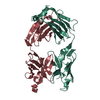

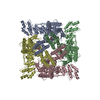
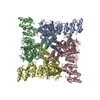


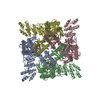


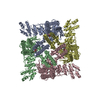

 PDBj
PDBj


